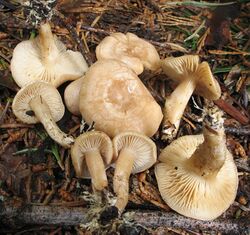Biology:Clitocybe albirhiza
| Clitocybe albirhiza | |
|---|---|

| |
| Scientific classification | |
| Domain: | Eukaryota |
| Kingdom: | Fungi |
| Division: | Basidiomycota |
| Class: | Agaricomycetes |
| Order: | Agaricales |
| Family: | Clitocybaceae |
| Genus: | Clitocybe |
| Species: | C. albirhiza
|
| Binomial name | |
| Clitocybe albirhiza H.E.Bigelow & A.H.Sm. (1963)
| |
Clitocybe albirhiza, commonly known as the snowmelt clitocybe, is a species of agaric fungus in the family Tricholomataceae. It is found in high-elevation locations in the western United States.
Taxonomy
American mycologists Howard E. Bigelow and Alexander H. Smith first described the species officially in 1963, from specimens collected in June, 1954, near Payette Lake, Idaho.[1]
The species name refers to mycelial cords (rhizomorphs), which extend from the base.[2]
Description
The cap measures 2–8 cm (3⁄4–3 1⁄8 in),[3] and is initially convex before flattening and finally becoming funnel-shaped. Its color depends on its state of hydration: when dry, it is buff; when wet, it is cinnamon-buff to clay color (often with concentric differentiations); new blooms are typically whitish.[2] The gills have an adnate to decurrent attachment to the stipe and are closely spaced, sometimes with "veins" connected between them; they are roughly the same color as the cap, or paler. The stipe measures 2–8 cm (3⁄4–3 1⁄8 in) long by 0.5–2 cm (1⁄4–3⁄4 in) wide,[3] and is either equal in width throughout, or tapers on either end. Initially stuffed with a cottony mycelium when young, it hollows in maturity. Colored similar to the cap, the stipe surface ranges from smooth to canescent (covered with a whitish-grey bloom) when wet, to fibrillose-striate when dry. The stipe base features a dense mass of whitish rhizomorphs embedded with needles and other forest debris. The flesh is mostly thin except for the disc (a circular region in the center of the cap). It has a slight to unpleasant odor and a poor, bitter taste.[1] The mushroom is considered inedible.[4]
The spore print is white. The spores are smooth and elliptical, with dimensions of 4.5–6 by 2.5–3.5 µm. The basidia (spore-bearing cells) are typically two- or four-spored (rarely, one-spored) and measure 20–30 by 3.5–5 µm. The hymenium lacks cystidia. Clamp connections are present in the hyphae.[1]
Habitat and distribution
| Clitocybe albirhiza | |
|---|---|
| Mycological characteristics | |
| gills on hymenium | |
| cap is convex or umbonate | |
| hymenium is adnate or decurrent | |
| stipe is bare | |
| spore print is white | |
| edibility: unknown | |
Fruit bodies of Clitocybe albirhiza grow scattered, in groups, or in clusters under spruce, or, occasionally, larch and pine. Found in the US states of Idaho,[1] Washington (state) ,[5] and Wyoming,[6] it is abundant in some high-elevation 5,000–10,000 ft (1,500–3,000 m) locations in the Rocky Mountains. It is referred to as a "snowbank mushroom" because fruit bodies typically appear around the edges of melting snowbanks.[7] Fruitings occur most frequently in June and early July, about the same time as snowmelt at the elevations in which the species occurs.[1] In the Cascade Mountains of Washington, C. albirhiza is one of the most common fungi growing on non-serpentine soil.[5]
Similar species
Clitocybe glacialis and Melanoleuca angelesiana are similar in appearance.[3] Clitocybe ramigena is similar, but smaller and not so bitter.[2]
References
- ↑ 1.0 1.1 1.2 1.3 1.4 "Clitocybe species from the Western United States". Mycologia 54 (5): 498–515. 1962. doi:10.2307/3756319.
- ↑ 2.0 2.1 2.2 Trudell, Steve; Ammirati, Joe (2009). Mushrooms of the Pacific Northwest. Timber Press Field Guides. Portland, OR: Timber Press. pp. 89–90. ISBN 978-0-88192-935-5. https://books.google.com/books?id=WevHvt6Tr8kC.
- ↑ 3.0 3.1 3.2 Davis, R. Michael; Sommer, Robert; Menge, John A. (2012). Field Guide to Mushrooms of Western North America. Berkeley: University of California Press. pp. 145–146. ISBN 978-0-520-95360-4. OCLC 797915861. https://www.worldcat.org/oclc/797915861.
- ↑ Phillips, Roger (2010). Mushrooms and Other Fungi of North America. Buffalo, NY: Firefly Books. p. 63. ISBN 978-1-55407-651-2.
- ↑ 5.0 5.1 "Mycoecology on serpentine soil". Mycologia 61 (6): 1106–1116. 1969. doi:10.2307/3757496. PMID 4314286.
- ↑ "Macrofungi collected from the Black Hills of South Dakota and Bear Lodge Mountains of Wyoming". American Midland Naturalist 152 (1): 43–62. 2004. doi:10.1674/0003-0031(2004)152[0043:mcftbh2.0.co;2].
- ↑ Field Guide to Mushrooms of Western North America. University of California Press. 2012. pp. 145–146. ISBN 978-0-520-95360-4.
External links
Wikidata ☰ Q15637417 entry
 |

